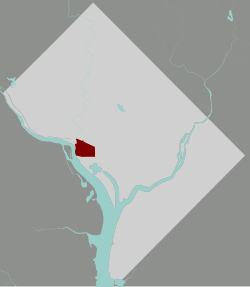Foggy Bottom
|
Foggy Bottom Historic District
|
|

Aerial view of Foggy Bottom. The Watergate Complex is in the foreground.
|
|
 |
|
| Location | Bounded by 17th St., Rock Creek Parkway, Constitution Ave., Pennsylvania Ave., NW, Washington, D.C. |
|---|---|
| NRHP Reference # | 87001269 |
| Added to NRHP | October 14, 1987 |
Foggy Bottom is one of the oldest late 18th and 19th-century neighborhoods in Washington, D.C. Foggy Bottom is west of downtown Washington, in the Northwest quadrant, bounded roughly by 17th Street to the east, Rock Creek Parkway to the west, Constitution Avenue to the south, and Pennsylvania Avenue to the north. Much of Foggy Bottom is occupied by the main campus of George Washington University (GWU). Foggy Bottom is thought to have received its name due to its riverside location, which made it susceptible to concentrations of fog and industrial smoke, an atmospheric quirk.
The United States Department of State gained the metonym "Foggy Bottom" when it moved its headquarters to the nearby Harry S Truman Building in 1947.
The Foggy Bottom area was the site of one of the earliest settlements in what is now the District of Columbia, when German settler Jacob Funk subdivided 130 acres (0.53 km2) near the meeting place of the Potomac River and Rock Creek in 1763. The settlement officially was named Hamburgh, but colloquially was called Funkstown. In 1765, German settlers established the town of Hamburg on what would become the area between 24th and 18th NW Street. Jacob Funk (or Funck), the recorded founder of Hamburg, allegedly bought the land and divided it into 287 lots of land. There are reportedly two more founders: Robert Peter and James Linigan. The three had control of the land until 1791 when the territories were given to the city of Washington and the United States government. In the town of Hamburg, a German community was founded by many German immigrants.
In 1768, Funk sold two lots of territory to both the German Lutheran and the German Presbyterian communities. The lot that was sold to the German Lutherans was located on the corner of 20th and G Street. The lot sold to the German Presbyterians was located on the southeast corner of 22nd and G Street. The Lutheran lot would not be in use until 1833 and the Presbyterian until the 1880s. The lot that was sold to the German Lutheran community was turned into the Concordia German Church.
...
Wikipedia
